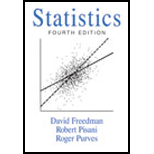
(a)
Delineate whether it is usual that an investigator would get as many pairs as Person R with the treatment animal having the heavier cortex.
(a)
Answer to Problem 12RE
There is no evidence that there appears to be 50-50 chance for each animal in a pair to have heavier cortex.
Explanation of Solution
Let ‘T’ represent the treatment and ‘C’ represent the control.
The cortex weight of the animal in the treatment is 689 milligrams and the cortex weight of the animal in the control is 657 milligrams.
Based on the given information, the following values are known.
On observing the table, 52 pairs have higher value for the treatment and 7 have higher value for the control group.
Let ‘0’ represent the tails.
Let ‘1’ represent the heads.
In this scenario, consider a box containing 2 tickets in which 1 ticket is labeled 1 and 1 ticket is labeled 0.
Therefore, the null hypothesis states that the number of higher values for the treatment is the sum of 59 random draws (with replacement) from a box containing a ticket labeled 1 and a ticket labeled 0.
On the other hand, the alternative hypothesis states that there are many higher values.
The expected value sum is as given below:
The expected value is obtained using the product of the percentage of 1’s in the box and the number of draws.
Standard deviation of the box:
Standard error of the sum:
The known values are given below:
The formula for z-score is as follows:
The z-score is obtained as given below:
The probability P is given below:
Using the standard normal table, the value corresponding to
Remaining calculation:
Since the P-value is less than any of the level of significance, it is unusual to obtain a difference in the sample percentage of 50% when there is difference in the population percentage and thus, the difference does not appear due to chance variation.
Therefore, there is evidence that there appears to be no 50-50 chance for each animal in a pair to have a heavier cortex.
(b)
Obtain the average and SD of the difference.
State whether there is evidence that the treatment has no effect.
(b)
Answer to Problem 12RE
There is no evidence that the treatment has no effect.
Explanation of Solution
Based on the given information, the following values are known:
The mean of the sample is as given below:
The standard deviation is as given below:
The standard error of the sum is given below:
The standard error of the average is the standard error of the sum divided by the number of draws, which is given below:
The test hypotheses are given below:
Let
Null hypothesis:
Alternative hypothesis:
The formula for test statistic is as follows:
Known values:
The z-score is obtained as given below:
The P-value is given below:
Using the standard normal table, the value corresponding to
Since the P-value is less than any of the level of significance, it is unusual to obtain a difference in the sample average of 36.2373 when there is difference in the population averages and thus, the difference does not appear due to chance variation.
Therefore, the treatment appears to have an effect.
(c)
Discuss about the point of precaution and also state whether it is a good idea.
(c)
Answer to Problem 12RE
The point of precaution is a good idea.
Explanation of Solution
In this context, a precaution was made that the dissection of a set of littermates were executed at random and the person performing the partition will not know which cage the rate came from.
The random order of the execution of the dissections is important because it is possible that the second cortex weight will always be more accurate than the first cortex weight due to the experience that is influencing the weighing.
It is also important that the person performing the dissections does not know which littermates received which treatments. Hence, a person could influence the results when he/she knows which treatments were received by those littermates.
Therefore, the precautions were made to make the weighing more accurate and less influenced by bias.
Thus, the point of precaution is a good idea.
Want to see more full solutions like this?
Chapter 26 Solutions
Statistics
 MATLAB: An Introduction with ApplicationsStatisticsISBN:9781119256830Author:Amos GilatPublisher:John Wiley & Sons Inc
MATLAB: An Introduction with ApplicationsStatisticsISBN:9781119256830Author:Amos GilatPublisher:John Wiley & Sons Inc Probability and Statistics for Engineering and th...StatisticsISBN:9781305251809Author:Jay L. DevorePublisher:Cengage Learning
Probability and Statistics for Engineering and th...StatisticsISBN:9781305251809Author:Jay L. DevorePublisher:Cengage Learning Statistics for The Behavioral Sciences (MindTap C...StatisticsISBN:9781305504912Author:Frederick J Gravetter, Larry B. WallnauPublisher:Cengage Learning
Statistics for The Behavioral Sciences (MindTap C...StatisticsISBN:9781305504912Author:Frederick J Gravetter, Larry B. WallnauPublisher:Cengage Learning Elementary Statistics: Picturing the World (7th E...StatisticsISBN:9780134683416Author:Ron Larson, Betsy FarberPublisher:PEARSON
Elementary Statistics: Picturing the World (7th E...StatisticsISBN:9780134683416Author:Ron Larson, Betsy FarberPublisher:PEARSON The Basic Practice of StatisticsStatisticsISBN:9781319042578Author:David S. Moore, William I. Notz, Michael A. FlignerPublisher:W. H. Freeman
The Basic Practice of StatisticsStatisticsISBN:9781319042578Author:David S. Moore, William I. Notz, Michael A. FlignerPublisher:W. H. Freeman Introduction to the Practice of StatisticsStatisticsISBN:9781319013387Author:David S. Moore, George P. McCabe, Bruce A. CraigPublisher:W. H. Freeman
Introduction to the Practice of StatisticsStatisticsISBN:9781319013387Author:David S. Moore, George P. McCabe, Bruce A. CraigPublisher:W. H. Freeman





